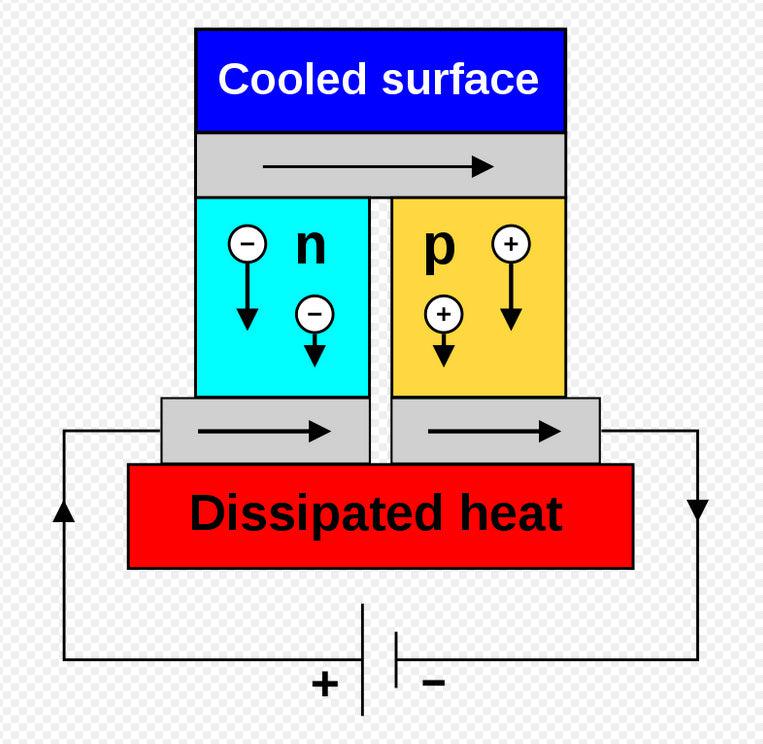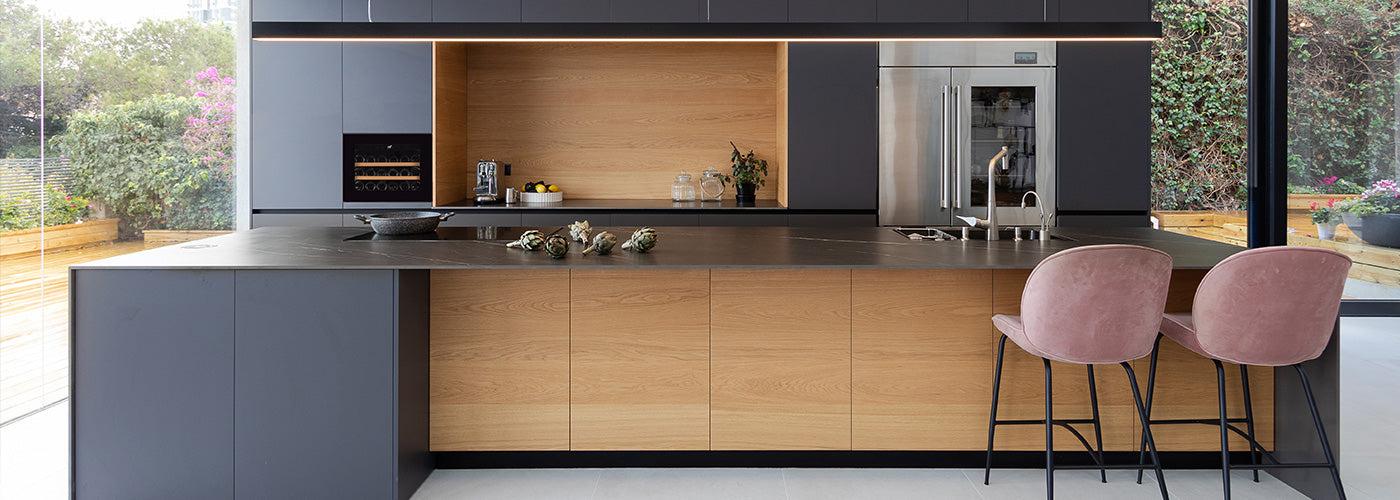
There are two main types of wine coolers or chillers, and these are compressor and thermoelectric coolers. They may seem little difference between these upon first glance, but they actually operate very differently.
Wine coolers and chillers don’t tend to come cheap, so it's very important to do your research and find out what you’re paying for before you go ahead and hand over your cash.
Listen to this post here:
In this guide, we’ll discuss the pros and cons of thermoelectric wine coolers and compressor wine coolers in depth so you can come to an informed decision on what’s right for you and your wine storage needs.
How Does A Thermoelectric Wine Cooler Work?
A thermoelectric wine cooler works using the Peltier effect. This effect takes its name from the scientist who first discovered it in the 19th century. When electric charges travel through the two joined metal pieces, a heat flux is created with heat being sent from one side of the machine to the other. Whilst one side warms up, the other cools down.
The heat pump inside the machine is very small. Semiconductor wires are placed between the two ceramic plates.

Source: Wikipedia
Thermoelectric heat pumps work silently, largely because they are modestly sized and have no moving parts. This is one reason why so many people choose them over machines that depend on vapour compression.
In wine coolers, heat pumps work with heat sinks. These sinks are large components that are manufactured from aluminium fins. These enable heat to dissipate effectively.
The cold part of the pump-heat sink is inserted into the wine cooler interior. The host side is protected by a back panel as it extends outside of the back of the compartment.
The ventilation process is aided by fans at each side of the heat sink. Cool air is circulated more evenly, whilst heat is expelled more efficiently due to the work carried out by the fans.
Related: What Size Bottle Will Fit in My Wine Fridge?
Benefits of Thermoelectric Wine Coolers
A key benefit of a thermoelectric cooler is that it doesn’t rely on refrigerants that harm the environment.
Another advantage we haven’t mentioned yet is that they require less electricity than compressor systems. This will allow you to keep your fuel bills down when chilling your wine.
The small internal fans inside the coolers are the only moving parts. This means you can expect your system to operate much more quietly than your traditional household fridge. A silent wine fridge can be a particularly useful in a high end kitchen space.
Another big benefit of opting for a thermoelectric wine cooler is that these systems are almost free from vibrations. This means there’s little risk of upsetting or disturbing your wine.
As a result of this, you can expect your wine to still taste great when it’s time to consume it. These systems also have a more consistent temperature on the interior.
Compressor cooler temperatures can vary considerably, and there can be around 10 degrees of fluctuation. With a thermoelectric cooler, you can expect much more consistency in terms of temperature.

What Are The Downsides of Thermoelectric?
There are some limitations you need to think about before you go ahead and buy a thermoelectric cooler.
A thermoelectric cooler doesn’t reach the temperatures a compressor cooler can. The vast majority of thermoelectric coolers can’t cool below 50°F. However, it is possible to source one that reaches 44°F.
Your thermoelectric cooler might not be very efficient if it gets too hot. Instead of producing cold air, the system will take heat from inside your cooler compartment. However, if the environment reaches a temperature over 80°F, it may struggle to remove sufficient heat to keep your wine stored at the ideal temperature of 55°F.
Similarly, your system may not work when it gets too cold. As there is no way to add heat to the cooler, if the ambient temperature falls beneath 50°F, the internal temperature will also drop. This can have a negative impact on wine storage.
To find a thermoelectric cooler that works for you, take a close look at the manufacturer specifications. Make sure the thermostat range suits your specific needs, and follow any instructions that come with the package if you do go ahead and make a purchase.
You also need to store your cooler in a suitable place. Coolers are designed to be used in indoor environments such as kitchens. You shouldn’t keep your cooler outside, in a shed or in a garage.
Related: Glass or Solid Door Wine Cooler?
How Does a Compressor Wine Chiller Work And What Are The Benefits?
A compressor wine cooler can be seen as a smaller version of a conventional refrigerator. It uses the vapour compression cycle to take heat from inside the cabinet. The vapour compression refrigeration system is based around the same kind of technology that powers air conditioners.
Coolant gases transport heat from the inside of the system before expelling it externally. The four main parts of the system are the compressor, condenser, expansion valve and evaporator.

With the vast majority of wine coolers, the cold air made the evaporator is sent through an aluminium panel. This panel radiates cold air into the interior of the cabinet to lower the temperature. There are models on the market which use fans to circulate air and create a more even temperature.
One of the advantages of compressor coolers is that the temperature can get much colder than what you’ll see with a thermoelectric cooler. As most thermoelectric coolers can’t cool below around 50°F, you won’t be able to achieve the kind of temperatures recommended by experts for drinks like sparkling wines and champagne.
It’s not advisable to use thermoelectric coolers in environments that regularly get warmer than 80°. The reason for this is that the Peltier device doesn’t offer fantastic heat flux and is only capable of reducing temperatures by around 20 degrees.
You may be able to reach the required temperature when your home is cool, but things will be much more difficult when you want to warm it up.
A compressor cooler can easily get to temperatures around the thirties and can reach the temperature you require throughout the year.
Another benefit of compressors is that they will cost you less to operate. Whilst thermoelectric coolers are constantly in operation, compressor power on and off when necessary to maintain the required temperature.
Continuous power can result in a considerable fuel bill rise and makes it more likely that parts will break down due to the constant demands placed on them.
The energy efficiency of a thermoelectric cooler is heavily influenced by ambient temperatures. The bigger the difference between wine cooler and room temperatures, the more energy is required.
Size and configuration also have a big influence on how energy efficient your cooler is. The bigger your wine cooler is, the more Peltier devices you’ll need to keep the cabinet cool.
Even though a larger compressor cooler may require a larger compressor, this is still only one device to consider rather than several Peltier devices. If you need a large cooler to store a considerable amount of wine, you can expect to lower operational costs by opting for a compressor unit.
Related: Freestanding vs Built In Wine Coolers - Which is Best?
Choosing The Right Wine Cooler Style
Other factors you need to think about when choosing a wine cooler include how often you’ll be opening it and how much wine you drink. Read on to find out more about choosing the right wine cooler style for your specific needs.
Who is a compressor wine cooler best for?
Compressor wine coolers tend to be best suited to frequent wine drinkers as well as those that have only just started building a wine collection. Compressor wine coolers are available in a wide range of sizes.
Smaller compressor wine coolers are available for those who only need to store a few bottles at a time, whilst hospitality venues like bars, clubs, hotels and restaurants can cool win quickly and reduce their fuel bills with a large compressor cooler.
Who is a thermoelectric wine cooler best for?
Thermoelectric wine coolers tend to be best suited to people who have a fairly large collection but don’t actually consume wine too often. If you’re storing wine for long periods but not drinking it too frequently, the lack of vibration could be a big draw for you.
There is less chance of wine you’re storing on a long-term basis being damaged by vibration if you opt for a thermoelectric wine cooler. Vibration is less likely to be a problem for hospitality venues with bottles that are served up to customers quickly or people who go through a large amount of wine at home.

There is no ‘right’ answer to the question ‘which is best: a compressor wine cooler or a thermoelectric wine cooler’. What’s right for one person may be completely wrong for you. Think about how long you tend to store wine for, how much wine you store and whether noise and vibrations are likely to irritate you.
Whichever choice you opt for, there are many types of compressor and thermoelectric wine coolers on the market. This means you shouldn’t struggle to find something that meets your requirements regardless of what they are.
Maintaining Your Thermoelectric Wine Cooler
Once you have purchased your thermoelectric wine cooler, you’ll need to take specific steps to continue benefitting from it as much as possible. You should store your cooler somewhere that has an ambient temperature or between 50° to 80°F.
Make sure there’s around 5 inches of space around the cooler at least. This allows for sufficient ventilation.
If there’s not enough ventilation available, the heat pump could overheat before burning out. Never install a freestanding wine cooler in a cabinet. Some units are designed to be built-in, and these have visible ventilation mechanisms. If yours doesn’t have these, it needs enough space for ventilation.
Even if you have opted for a thermoelectric wine cooler, it may still make unexpected noise.
This can be because it’s not been evenly balanced or placed on a level surface. Some coolers come with adjustable levelling feet which you can use if you do have uneven flooring.
If you are still hearing noise after levelling your cooler, you may have obstructed fans. Take a look inside to see if anything around the fans could be causing this unwanted noise.
Related posts:








 Author:
Author: 


Leave a comment (all fields required)